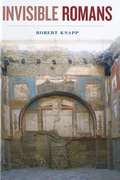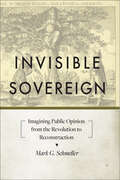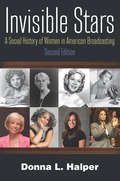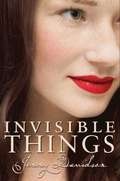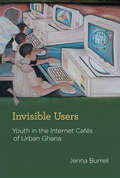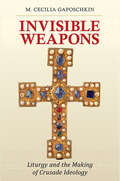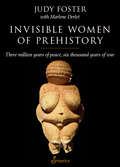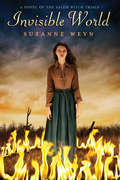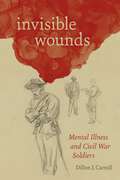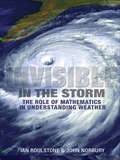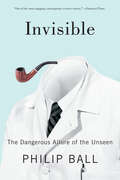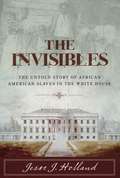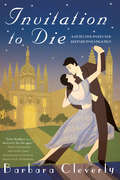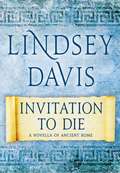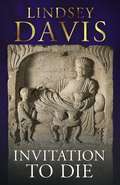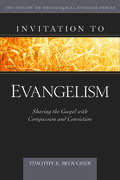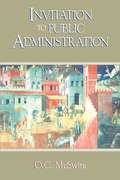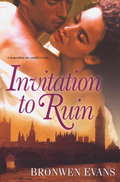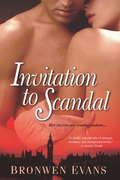- Table View
- List View
Invisible Romans
by Robert KnappRobert Knapp brings to light the laboring men, housewives, prostitutes, freedmen, slaves, soldiers, and gladiators who formed the backbone of the ancient Roman world, and the outlaws and pirates who lay beyond it. The lives of these invisible Romans emerge from graffiti, incantations, fables, astrological writings, and even the New Testament.
Invisible Sovereign: Imagining Public Opinion from the Revolution to Reconstruction (New Studies in American Intellectual and Cultural History)
by Mark G. SchmellerHow has the idea of public opinion changed since the Revolutionary War—and how has it shaped the nation?In the early American republic, the concept of public opinion was a recent—and ambiguous—invention. While appearing to promise a new style and system of democratic and deliberative politics, the concept was also invoked to limit self-rule, cement traditional prejudices and hierarchies, forestall deliberation, and marginalize dissent. As Americans contested the meaning of this essentially contestable idea, they expanded and contracted the horizons of political possibility and renegotiated the terms of political legitimacy.Tracing the notion of public opinion from its late eighteenth-century origins to the Gilded Age, Mark G. Schmeller’s Invisible Sovereign argues that public opinion is a central catalyst in the history of American political thought. Schmeller treats it as a contagious idea that infected a broad range of discourses and practices in powerful, occasionally ironic, and increasingly contentious ways. Ranging across a wide variety of historical fields, Invisible Sovereign traces a shift over time from early "political-constitutional" concepts, which identified public opinion with a sovereign people and wrapped it in the language of constitutionalism, to more modern, "social-psychological" concepts, which defined public opinion as a product of social action and mass communication.
Invisible Sovereign: Imagining Public Opinion from the Revolution to Reconstruction (New Studies in American Intellectual and Cultural History)
by Mark G. SchmellerThis history of early American political thought examines the emergence, evolution, and manipulation of public opinion. In the early American republic, the concept of public opinion was a recent—and ambiguous—invention. While appearing to promise a new style of democratic politics, the concept was also invoked to limit self-rule, cement traditional prejudices, stall deliberation, and marginalize dissent. As Americans contested the meaning of this essentially contestable idea, they expanded and contracted the horizons of political possibility and renegotiated the terms of political legitimacy. Tracing the concept from its late eighteenth-century origins to the Gilded Age, Mark G. Schmeller&’s Invisible Sovereign argues that public opinion is a central catalyst in the history of American political thought. Schmeller treats it as a contagious idea that infected a broad range of discourses and practices in powerful, occasionally ironic, and increasingly contentious ways. Ranging across a wide variety of historical fields, Invisible Sovereign traces a shift over time from early &“political-constitutional&” concepts, which wrapped pubic opinion in the language of constitutionalism, to more modern, &“social-psychological&” concepts, which defined public opinion as a product of social action and mass communication.
Invisible Stars: A Social History of Women in American Broadcasting
by Donna HalperInvisible Stars was the first book to recognize that women have always played an important part in American electronic media. The emphasis is on social history, as the author skillfully explains how the changing role of women in different eras influenced their participation in broadcasting. This is not just the story of radio stars or broadcast journalists, but a social history of women both on and off the air. Beginning in the early 1920s with the emergence of radio, the book chronicles the ambivalence toward women in broadcasting during the 1930s and 1940s, the gradual change in status of women in the 1950s and 1960s, the increased presence of women in broadcasting in the 1970s, and the successes of women in broadcasting in the 1980s and 1990s. The second edition is expanded to include the social and political changes that occurred in the 2000s, such as the growing number of women talk show hosts; changing attitudes about women in leadership roles in business; more about minority women in media; and women in sports and women sports announcers. The author addresses the question of whether women are in fact no longer invisible in electronic media. She provides an assessment of where progress for women (in society as well as broadcasting) can be seen, and where progress appears totally stalled.
Invisible Storytellers: Voice-Over Narration in American Fiction Film
by Sarah KozloffSarah Kozloff examines and analyzes voice-over narration through examples from films and refutes the assumptions that words should only play a minimal role in film, that "showing" is superior to "telling," or that the technique is inescapably authoritarian.
Invisible Things
by Jenny DavidsonSixteen-year-old Sophie knows there is more to the story of her parents' death. And she's on a mission to find the truth. To aid her in solving the decades-old mystery, Sophie has enlisted her best friend, Mikael, whose friendship has turned into something more. It's soon clear that Sophie's future is very much wrapped up in the details of her family's past, and the key lies with information only one man can provide: her parents' former employer, the elusive billionaire Alfred Nobel. As the threat of war looms in Europe, dangers to Sophie and her loved ones grow. While her determination to solve the mystery doesn't waver, forces beyond her control conspire to keep her from her purpose. Then, news of her great-aunt Tabitha's death sets off a chain of events that leaves Sophie questioning everything. The more Sophie learns, the more she realizes that nothing--and no one--in her life is what it seems. And coming to terms with the dark secrets she uncovers means imagining a truth that she never dreamed possible. Full of gorgeous settings, thrilling adventure, and romance, invisible things is a novel that dares to ask, what if?
Invisible Users: Youth in the Internet Cafés of Urban Ghana (Acting with Technology)
by Jenna BurrellAn account of how young people in Ghana's capital city adopt and adapt digital technology in the margins of the global economy.The urban youth frequenting the Internet cafés of Accra, Ghana, who are decidedly not members of their country's elite, use the Internet largely as a way to orchestrate encounters across distance and amass foreign ties—activities once limited to the wealthy, university-educated classes. The Internet, accessed on second-hand computers (castoffs from the United States and Europe), has become for these youths a means of enacting a more cosmopolitan self. In Invisible Users, Jenna Burrell offers a richly observed account of how these Internet enthusiasts have adopted, and adapted to their own priorities, a technological system that was not designed with them in mind.Burrell describes the material space of the urban Internet café and the virtual space of push and pull between young Ghanaians and the foreigners they encounter online; the region's famous 419 scam strategies and the rumors of “big gains” that fuel them; the influential role of churches and theories about how the supernatural operates through the network; and development rhetoric about digital technologies and the future viability of African Internet cafés in the region.Burrell, integrating concepts from science and technology studies and African studies with empirical findings from her own field work in Ghana, captures the interpretive flexibility of technology by users in the margins but also highlights how their invisibility puts limits on their full inclusion into a global network society.
Invisible Weapons: Liturgy and the Making of Crusade Ideology
by M. Cecilia GaposchkinThroughout the history of the Crusades, liturgical prayer, masses, and alms were all marshaled in the fight against Muslim armies. In Invisible Weapons, M. Cecilia Gaposchkin focuses on the ways in which Latin Christians communicated their ideas and aspirations for crusade to God through liturgy, how public worship was deployed, and how prayers and masses absorbed the ideals and priorities of crusading. Placing religious texts and practices within the larger narrative of crusading, Gaposchkin offers a new understanding of a crucial facet in the culture of holy war.
Invisible Women of Prehistory: Three Million Years of Peace, Six Thousand Years of War
by Marlene Derlet Judy FosterBased on many years of research into ancient history and prehistory, this insightful tome argues that three million years of peace--a period when women's status in society was much higher than it is now--preceded the last 6,000 years of war during which men have come to hold power over women. The book challenges the idea accepted in academia that history is a linear development in which society is steadily moving out of a violent and patriarchal past to a more equitable and peaceful future, and it reexamines both the archaeological work of Marjia Gimbutas and recent research into the prehistories of Africa, Asia, the Americas, and Australia and Oceania.
Invisible World
by Suzanne WeynSuzanne Weyn brings her trademark mix of history, romance, and the supernatural to the Salem Witch Trials. For 15-year-old Sarah Owen, having a scientist father is a blessing and a curse. He doesn't bat an eye at her pyschic abilities, since he researches them; and she knows more about the invisible worlds of microbes, electricity, and gravity than most girls in the 17th Century. But when Sarah travels to the Americas with her father to do more research, she's shipwrecked and lands for a time on the Gullah Islands. Later, when the plantation owners find her and send her north to Salem, Massachusetts, her abilities get her into trouble. Can Sarah save herself when she's accused of witchcraft? Or will she and the rest of the innocents she's accused with be found guilty...and sentenced to hanging?
Invisible Wounds of War: Summary and Recommendations for Addressing Psychological and Cognitive Injuries
by Terri Tanielian Lisa H. Jaycox Grant N. Marshall M. Audrey Burnam Terry L. SchellSummarizes key findings and recommendations from Invisible Wounds of War: Psychological and Cognitive Injuries, Their Consequences, and Services to Assist Recovery (Tanielian and Jaycox [Eds.], MG-720-CCF, 2008), a comprehensive study of the post-deployment health-related needs associated with post-traumatic stress disorder, major depression, and traumatic brain injury among veterans of Operations Enduring Freedom/Iraqi Freedom.
Invisible Wounds: Mental Illness and Civil War Soldiers (Conflicting Worlds: New Dimensions of the American Civil War)
by Dillon CarrollDillon J. Carroll’s Invisible Wounds examines the effects of military service, particularly combat, on the psyches and emotional well-being of Civil War soldiers—Black and white, North and South. Soldiers faced harsh military discipline, arduous marches, poor rations, debilitating diseases, and the terror of battle, all of which took a severe psychological toll. While mental collapses sometimes occurred during the war, the emotional damage soldiers incurred more often became apparent in the postwar years, when it manifested itself in disturbing and self-destructive behavior. Carroll explores the dynamic between the families of mentally ill veterans and the superintendents of insane asylums, as well as between those superintendents and doctors in the nascent field of neurology, who increasingly believed the central nervous system or cultural and social factors caused mental illness. Invisible Wounds is a sweeping reevaluation of the mental damage inflicted by the nation’s most tragic conflict.
Invisible in the Storm
by John Norbury Ian RoulstoneInvisible in the Storm is the first book to recount the history, personalities, and ideas behind one of the greatest scientific successes of modern times--the use of mathematics in weather prediction. Although humans have tried to forecast weather for millennia, mathematical principles were used in meteorology only after the turn of the twentieth century. From the first proposal for using mathematics to predict weather, to the supercomputers that now process meteorological information gathered from satellites and weather stations, Ian Roulstone and John Norbury narrate the groundbreaking evolution of modern forecasting. The authors begin with Vilhelm Bjerknes, a Norwegian physicist and meteorologist who in 1904 came up with a method now known as numerical weather prediction. Although his proposed calculations could not be implemented without computers, his early attempts, along with those of Lewis Fry Richardson, marked a turning point in atmospheric science. Roulstone and Norbury describe the discovery of chaos theory's butterfly effect, in which tiny variations in initial conditions produce large variations in the long-term behavior of a system--dashing the hopes of perfect predictability for weather patterns. They explore how weather forecasters today formulate their ideas through state-of-the-art mathematics, taking into account limitations to predictability. Millions of variables--known, unknown, and approximate--as well as billions of calculations, are involved in every forecast, producing informative and fascinating modern computer simulations of the Earth system. Accessible and timely, Invisible in the Storm explains the crucial role of mathematics in understanding the ever-changing weather.Some images inside the book are unavailable due to digital copyright restrictions.
Invisible: The Dangerous Allure of the Unseen
by Philip Ball“A very fun, largely chronological journey through invisibility, beginning with myth and early magicians, ending with quantum physics.” —The New YorkerIn this lively look at a timeless idea, Ball provides the first comprehensive history of our fascination with the unseen. This sweeping narrative moves from medieval spell books to the latest nanotechnology, from fairy tales to telecommunications, from camouflage to ghosts to the dawn of nuclear physics and the discovery of dark energy. Along the way, Invisible tells little-known stories about medieval priests who blamed their misdeeds on spirits; the Cock Lane ghost, which intrigued both Samuel Johnson and Charles Dickens; the attempts by Victorian scientist William Crookes to detect forces using tiny windmills; novelist Edward Bulwer-Lytton’s belief that he was unseen when in his dressing gown; and military efforts to enlist magicians to hide tanks and ships during WWII. Bringing in such voices as Plato and Shakespeare, Ball provides not only a scientific history but a cultural one—showing how our simultaneous desire for and suspicion of the invisible has fueled invention and the imagination for centuries.In this unusual and clever book, Ball shows that our fantasies about being unseen—and seeing the unseen—reveal surprising truths about who we are.“Full of insights drawn from a broad survey of history, literature and philosophy; wherever the invisible is being contemplated, Ball is there to select the juiciest anecdotes . . . [He] is a lucid, witty and highly entertaining guide.” —The Globe and Mail“A tour-de-force history capped off with an animated discussion of H.G. Wells’s novel The Invisible Man.” —Publishers Weekly (starred review)
Invisibles: Untold Story of African American Slaves in the White House
by Jesse HollandTHE INVISIBLES: Slavery Inside The White House and How It Helped Shape America is the first book to tell the story of the executive mansion's most unexpected residents, the African American slaves who lived with the U. S. presidents who owned them. Interest in African Americans and the White House are at an all-time high due to the historic presidency of Barack Obama, and the soon-to-be-opened Smithsonian National Museum of African American Culture and History. The Invisibles chronicles the African American presence inside the White House from its beginnings in 1782 until 1862, when President Abraham Lincoln issued the Emancipation Proclamation that granted slaves their freedom. During these years, slaves were the only African Americans to whom the most powerful men in the United States were exposed on a daily, and familiar, basis. By reading about these often-intimate relationships, readers will better understand some of the views that various presidents held about class and race in American society, and how these slaves contributed not only to the life and comforts of the presidents they served, but to America as a whole.
Invitation to Die (An Inspector Redfyre Mystery #2)
by Barbara CleverlyAn “invitation to dine” quickly loses a letter as DI John Redfyre returns for his second investigation in the hallowed halls of Cambridge academia. Cambridge, 1924 in early summertime. May Balls, punting on the Cam, flirting and dancing the tango are the preoccupations of bright young people, but bright young Detective Inspector John Redfyre finds himself mired in multiple murders. One morning, his dog discovers a corpse neatly laid on a tombstone in the graveyard adjoining St. Bede’s College. An army greatcoat and well-worn boots suggest the dead man may have been a former soldier, though the empty bottle of brandy and a card bearing the words “An Invitation to Dine” on the victim ring a discordant note. Even more unsettling is the autopsy, which reveals death by strangulation and unusual contents in the stomach from the man’s last meal. Redfyre learns that this murder is one of several unsolved cases linked to a secretive and sinister dining club at St. Bede’s. Redfyre, himself an ex-rifleman, becomes caught in a dark tale of revenge, betrayal and injustice—a lingering mystery from a long-forgotten war. With the unlikely assistance of his lead suspect, he gradually unearths the dead man’s story and fights to right an ancient wrong.
Invitation to Die: A Novella of Ancient Rome
by Lindsey DavisIn 89 B.C.E., Roman emperor Domitian throws a terrifying banquet for the Senators—one that everyone is certain they won't survive—in Lindsey Davis's Invitation to Die: A Novella of Ancient Rome.The emperor Domitian is paranoid, autocratic, and violent. And he has a special grudge against both the Senate and the Camilli. So when a strange invitation to a banquet appears given by Domitian, it's not good news for Aulus and Quintus, the Camillus brothers. Both are Senators, brothers-in-law of Marcus Didius Falco, a disreputable private informer with his own past with Domitian, and nephews to a man who plotted to depose Domitian's father. But they dare not refuse an invitation from mercurial and vengeful Domitian. And their concerns were well founded—Domitian has gathered the most powerful men in Rome for what is known to history as The Black Banquet. The place markers are tombstones with names on it, the servers are slaves covered in black make-up, and Domitian speaks only of death. Aulus and Quintus—like all the attendees—are sure they will not survive the night.Bestselling historical novelist Lindsey Davis explores one of the more famous episodes in the reign of the much-feared 1st Century Emperor, through the extended family of her most famous creations—the brothers-in-law of Marcus Didius Falco and the uncle to his successor, Flavia Albia.
Invitation to Die: A Short Story of Falco's Rome
by Lindsey DavisEmperor Domitian is hosting a banquet for the senators in honour of fallen soldiers, and it's an invitation Aelianus and Justinus Camillus dare not refuse. On arrival, they enter a black-painted room furnished with couches resembling those found in mausoleums, complete with a tombstone bearing each of the senators' names. As the evening progresses the brothers conclude that Domitian has finally turned against them for their uncle's part in a plot to oust his father, and start to wonder if they'll ever see the light of day again . . .*************Praise for Lindsey Davis and the Flavia Albia series'Lindsey Davis has seen off all her competitors to become the unassailable market leader in the 'crime in Ancient Rome' genre . . . Davis's squalid, vibrant Rome is as pleasurable as ever' - Guardian'Davis's prose is a lively joy, and Flavia's Rome is sinister and gloriously real' - The Times on Sunday'For fans of crime fiction set in the ancient world, this one is not to be missed' - Booklist'Davis's books crackle with wit and knowledge . . . She has the happy knack of making the reader feel entirely immersed in Rome' - The Times
Invitation to Die: A Short Story of Falco's Rome
by Lindsey DavisEmperor Domitian is hosting a banquet for the senators in honour of fallen soldiers, and it's an invitation Aelianus and Justinus Camillus dare not refuse. On arrival, they enter a black-painted room furnished with couches resembling those found in mausoleums, complete with a tombstone bearing each of the senators' names. As the evening progresses the brothers conclude that Domitian has finally turned against them for their uncle's part in a plot to oust his father, and start to wonder if they'll ever see the light of day again . . .*************Praise for Lindsey Davis and the Flavia Albia series'Lindsey Davis has seen off all her competitors to become the unassailable market leader in the 'crime in Ancient Rome' genre . . . Davis's squalid, vibrant Rome is as pleasurable as ever' - Guardian'Davis's prose is a lively joy, and Flavia's Rome is sinister and gloriously real' - The Times on Sunday'For fans of crime fiction set in the ancient world, this one is not to be missed' - Booklist'Davis's books crackle with wit and knowledge . . . She has the happy knack of making the reader feel entirely immersed in Rome' - The Times
Invitation to Evangelism: Sharing the Gospel with Compassion and Conviction (Invitation to Theological Studies)
by Timothy BeougherEssential guidance for a lifestyle of sharing God’s good news with a lost world.What exactly does it mean to “evangelize” in a Christian sense? And how is such “evangelizing” supposed to be done? Longtime pastor, evangelist, and professor of evangelism Timothy K. Beougher answers these questions and more from theological, historical, and practical perspectives. Beougher demonstrates God’s goodness in evangelism through relatable anecdotes, Bible teaching, and encouraging instruction. Invitation to Evangelism welcomes believers into the experience of stepping out in faith of behalf of people God loves.Most Christians know that they should be sharing the good news of Jesus Christ with nonbelievers, and most also know they aren’t witnessing very well, or even at all. They need help internalizing the content of gospel proclamation and identifying the best way to go about making evangelism a natural part of their lives. Introduction to Evangelism guides readers through the essential issues of the gospel message, evangelism methods, and witnessing models so they are ready and excited to move out in faith as everyday evangelists.Beougher’s biblical, theological, historical, and practical teaching revolves around following essential aspects of being an evangelist:•Having compassion as the motivation for evangelism•Understanding the good news of Jesus Christ•Seeing lost people as persons God loves•Relying on the power of the Holy Spirit•Paving the way for new believers to share their faith eagerly with others
Invitation to Public Administration
by O. C. McSwiteThis engaging book presents a model for personal reflection on what a career in public service means. It's designed not to convince the reader to take up a public service career, but rather to invite him or her to explore the implications for one's identity that are inherent in the public service life. Lively and anecdotal, Invitation to Public Administration directly confronts the various difficult issues involved with a public service career even as it evokes self-reflection. It is equally useful for undergraduate through Ph.D. level readers, and it is ideal supplemental reading for any foundational course in Public Administration. The book will also stimulate public service professionals seeking fresh insights for their own careers.
Invitation to Ruin
by Bronwen EvansOne Good Lady Is About to Go Bad. . .The only thing Miss Melissa Goodly has ever wanted out of a marriage is love. But any hope of that dissolves one wild night, when she loses herself in the arms of the most irresistible--and unobtainable--man in all of England. For when they are discovered in a position as compromising as it is pleasurable, she has no choice but to accept his proposal. Avowed bachelor Anthony Craven, Earl of Wickham, never meant to seduce an innocent like Melissa. Yet now that the damage is done, it does seem like she'd make a very convenient wife. After all, she is so naive he won't have to worry about ever being tempted. Or so he thinks, until the vows are spoken and they are left alone--and his new bride reveals a streak just as brazen and unrestrained as his own. . .
Invitation to Scandal
by Bronwen EvansCatch Me If You CanPlagued by scandalous rumors, Rheda Kerrich will stop at nothing to restore her reputation and make an honest living for herself-and she's determined to do it without a husband. But times are hard, and smuggling is a risky though profitable trade. So when a dashing agent for the English government catches her in the act, she desperately resists his charms and conceals her illicit profession. Until she realizes he may be the key to her ultimate freedom-and unbridled passion . . . Rufus Knight, Viscount Strathmore, has never had trouble beguiling the ladies of Kent. When his search for 'Dark Shadow,' a cunningly elusive smuggler, leads him to alluring and headstrong Rhe, her objections to his amorous advances merely incite a tantalizing game of cat and mouse. Soon, they'll find the very secrets driving them apart could ensnare them in a love they can't escape . . . 'Passion, adventure, secrets and danger will keep you turning the pages. ' - Anna Campbell'A darkly sensual tale of intrigue, romance, and unexpected twists. ' - Lorraine Heath
Invitation to Scandal
by Bronwen EvansCatch Me If You CanPlagued by scandalous rumors, Rheda Kerrich will stop at nothing to restore her reputation and make an honest living for herself--and she's determined to do it without a husband. But times are hard, and smuggling is a risky though profitable trade. So when a dashing agent for the English government catches her in the act, she desperately resists his charms and conceals her illicit profession. Until she realizes he may be the key to her ultimate freedom--and unbridled passion. . .Rufus Knight, Viscount Strathmore, has never had trouble beguiling the ladies of Kent. When his search for "Dark Shadow," a cunningly elusive smuggler, leads him to alluring and headstrong Rhe, her objections to his amorous advances merely incite a tantalizing game of cat and mouse. Soon, they'll find the very secrets driving them apart could ensnare them in a love they can't escape. . ."Passion, adventure, secrets and danger will keep you turning the pages." --Anna Campbell "A darkly sensual tale of intrigue, romance, and unexpected twists." --Lorraine Heath
Invitation to Sociology
by Peter L. BergerAn introductory text to the field of sociology, called "witty and incisive."
